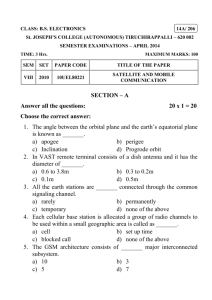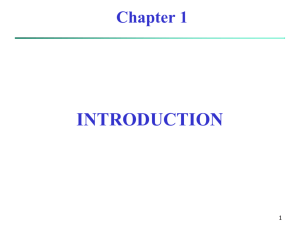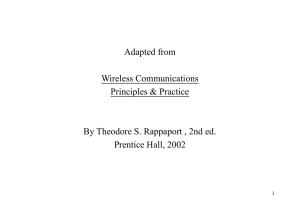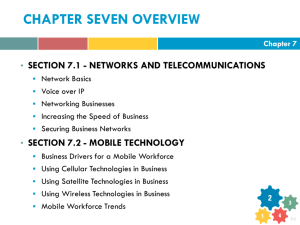Document
advertisement
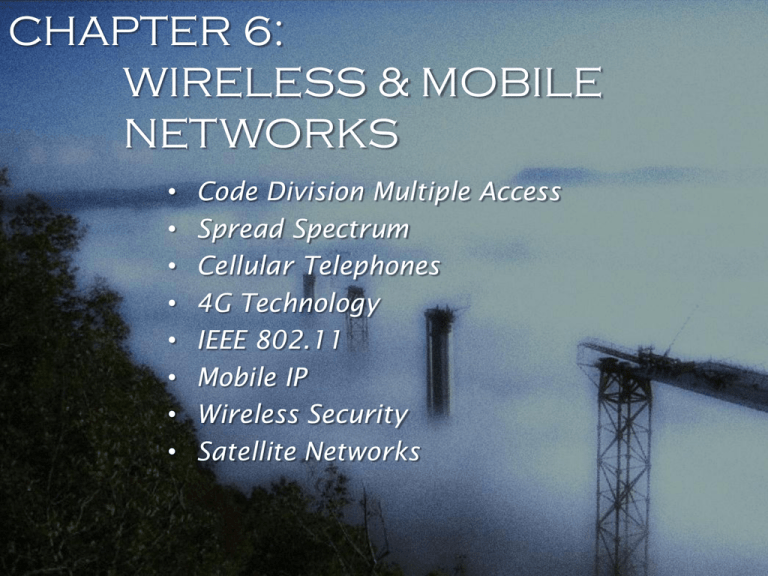
CHAPTER 6: WIRELESS & MOBILE NETWORKS • • • • • • • • Code Division Multiple Access Spread Spectrum Cellular Telephones 4G Technology IEEE 802.11 Mobile IP Wireless Security Satellite Networks CODE DIVISION MULTIPLE ACCESS TDMA: Everyone gets to talk using the entire bandwidth, but they have to take turns talking. FDMA: Everyone gets to talk at the same time, but only across their narrow channels. CDMA: Everyone gets to talk simultaneously, using the entire bandwidth! They do this by coding their transmissions in a unique fashion (as if every pair were speaking a different language, and each other language merely sounds like background noise). CS 447 Chapter 6 Page 159 COMPARING CELLULAR APPROACHES FDMA… • subject to impairment due to selective channel fading • limited to fixed number of concurrent users • not amenable to privacy needs • wasteful guard bands are needed between channels CS 447 TDMA… • subject to impairment due to noise bursts • limited to fixed number of concurrent users • not amenable to privacy needs • wasteful guard times are needed between time slots to ensure synchronization Chapter 6 CDMA… • frequency diversity avoids transmission impairments • experiences graceful degradation with more users • inherent privacy due to noiselike characteristics of other messages • efficiently utilizes the entire available bandwidth spectrum Page 160 SPREAD-SPECTRUM SIGNALING To eliminate the noise interference and privacy violations that have plagued wireless communication, spread-spectrum signaling was developed in two principal forms: Frequency Hopping Spread Spectrum (FHSS) • Each transmitter changes frequencies at a regular time interval, following a pseudorandom pattern known only to the transmitter and the receiver. • The receiver demodulates the received signal, filtering out any received signals that are not at the appropriate frequency. • FHSS is commonly used in Bluetooth systems. CS 447 Chapter 6 Page 161 Direct-Sequence Spread Spectrum (DSSS) • Each data bit is multiplied by a long bit sequence and modulated for transmission (the sequence used for 0 is the two’s complement of the signal used for 1). • Other transmitters must use orthogonal sequences so they’ll be filtered out at the receiver. CS 447 Chapter 6 Page 162 ORTHOGONAL DIGITAL SIGNALS A chip set of orthogonal vectors is used to “spread” the signals. Chip Code A: (1,1,1,1) Chip Code B: (1,1,-1,-1) Chip Code C: (1,-1,-1,1) Note that the chip codes are mutually orthogonal (i.e., the dot product of any pair of them is zero). Chip Code D: (1,-1, 1,-1) CS 447 Chapter 6 Page 163 CODING OUTGOING MESSAGES A: (1,1,1,1) B: (1,1,-1,-1) C: (1,-1,-1,1) Assume that there are four senders... Sender Message D: (1,-1, 1,-1) ±1 Version Chip Code Encoded Message W 010010 -1 1 -1 -1 1 -1 A (-1,-1,-1,-1), (1,1,1,1), (-1,-1,-1,-1), (-1,-1,-1,-1), (1,1,1,1), (-1,-1,-1,-1) X 111011 1 1 1 -1 1 1 B (1,1,-1,-1), (1,1,-1,-1), (1,1,-1,-1), (-1,-1,1,1), (1,1,-1,-1), (1,1,-1,-1) C (-1,1,1,-1), (-1,1,1,-1), (-1,1,1,-1), (1,-1,-1,1), (1,-1,-1,1), (1,-1,-1,1) D (1,-1,1,-1), (-1,1,-1,1), (1,-1,1,-1), (-1,1,-1,1), (-1,1,-1,1), (1,-1,1,-1) Y Z 000111 101001 -1 -1 -1 1 1 1 1 -1 1 -1 -1 1 Summing the four encoded messages yields: (0,0,0,-4), (0,4,0,0), (0,0,0,-4), (-2,-2,-2,2), (2,2,-2,2), (2,-2,-2,-2) CS 447 Chapter 6 Page 164 DECODING INCOMING MESSAGES What happens when the incoming message arrives? (0,0,0,-4), (0,4,0,0), (0,0,0,-4), (-2,-2,-2,2), (2,2,-2,2), (2,-2,-2,-2) Receiver Original Message Chip Code Decoded Message Decoded Message After Scaling W′ 010010 A -4, 4, -4, -4, 4, -4 010010 X′ 111011 B 4,4,4,-4,4,4 111011 Y′ 000111 C -4,-4,-4,4,4,4 000111 Z′ 101001 D 4,-4,4,-4,-4,4 101001 A: (1,1,1,1) B: (1,1,-1,-1) C: (1,-1,-1,1) The decoded message is “scaled” by converting all positive values to 1, and all non-positive values to 0. D: (1,-1, 1,-1) CS 447 Chapter 6 Page 165 CELLULAR TELEPHONES Cellular phones transmit and receive on two kinds of channels (FDM for analog, TDM for digital): •Control Channels – Used for overhead messages (e.g., network system ID), pages (incoming call signals), access info (connection requests), and channel assignments (when connection is established). •Communication Channels – Used for voice/data, handoff control, and maintenance monitoring. CS 447 Chapter 6 Page 166 CELLULAR BASE STATIONS Cellular providers typically have 832 (analog) channels to use. • 42 are reserved for control info. • The remaining 790 are split into 395 duplex pairs for voice/data. • The service region is split into a hexagonal grid, with approximately 56 channel pairs allocated to each base station. 1) The caller dials and the phone sends the phone number, programmed system ID, and phone serial number to the nearest base station. 2) After verifying everything, the base station relays the info to a mobile switching center, which then uses optical fiber or wireless to forward the caller’s signals. CS 447 Chapter 6 Page 167 CELLULAR HANDOFF As a user moves toward the edge of a cell, the local base station notes that the user’s signal strength is diminishing. Meanwhile, the base station in the cell towards which the user is moving (which is listening and measuring signal strength on all frequencies, not just its own one-seventh) detects the user’s signal strength increasing. The two base stations coordinate with each other through the Mobile Telephone Switching Office, and at some point, the user’s phone gets a signal on a control channel telling it to change frequencies. CS 447 Chapter 6 Page 168 MULTIPATH PROPAGATION Cellular signals may be altered via four principal types of interference. Shadowing occurs when the signal power fluctuates due to objects obstructing the propagation path between the transmitter and the receiver. Scattering occurs Reflection occurs when the signal when a radio wave travels through a collides with an medium containing object which has objects with very large dimensions smaller dimensions than the signal’s compared to the wavelength, such as wavelength of the when the propagating signal. transmission This is often caused Diffraction occurs when the encounters a rough by the surface of path between the transmitter surface or small the earth, buildings, and the receiver is obstructed objects. and walls by an object with sharp edges, causing secondary waves to bend around the object and provide an artificial line-of-sight between the communicating pair. CS 447 Chapter 6 Page 169 1G 2G 3G 4G Firstgeneration cellular systems were analog, using FDMA and emphasizing voice applications. Secondgeneration cellular systems are digital, using TDMA (or CDMA) and emphasizing email & Internet access. Thirdgeneration cellular systems are also digital, using CDMA and stressing video telephony and high-speed Internet access. Fourthgeneration cellular systems will extend the bandwidth and throughput capabilities of 3G. CDMA’s big advantages… • Frequency diversity limits transmission impairments. • Noise-like signal system improves privacy. • Graceful service degradation with increased usage. CS 447 Chapter 6 Page 170 4G’S MULTITECHNOLOGY APPROACH Numerous technologies are competing for a share of the 4G market, including: Orthogonal Frequency-Division Multiple Access (OFDMA) supports multi-user transmissions by separating them in both the time domain and in the frequency domain. Ultra-Wideband (UWB) uses the radio spectrum at low energy levels to produce short-range, high-bandwidth wireless communications. CS 447 Multiple-Input/MultipleOutput (MIMO) uses multiple antennas at both the transmitter and the receiver to improve communication performance. Chapter 6 Page 171 WIRELESS LANS Medium access control on wireless LANs has certain similarities to CSMA/CD. Three “interframe space” time values are defined: • Short IFS: time interval for high-priority traffic (e.g., ACKs and Clear-To-Sends) • Point Coordination Function IFS: time interval for polling messages • Distributed Coordination Function IFS: time interval for regular traffic A transmitting wireless station waits the appropriate IFS time, listening for traffic. If it hears a message, it waits until the message has passed, and then waits another IFS, plus an added exponential backoff time. Note that there is no collision detection (it’s too hard to tell the difference between external noise and one’s own transmission on such a wide-open medium). Corrupted signals must be handled at a higher protocol layer. CS 447 Chapter 6 Page 172 IEEE 802.11 TOPOLOGIES The 802.11 architecture hierarchically defines its topologies. An Independent Basic Service Set has wireless stations communicating directly with each other in a peer-to-peer fashion. An Infrastructure Basic Service Set has a component called an Access Point that serves as a relay through which the stations communicate with each other and which provides a connection to an external Distribution System. An Extended Service Set is a set of infrastructure BSS’s, where the access points communicate with each other to forward traffic from one BSS to another in order to facilitate movement of stations between BSS’s. CS 447 Chapter 6 Page 173 IEEE 802.11 FRAME FORMAT Preamble PLCP Header MAC Data CRC Preamble: 10 bytes of alternating 0’s and 1’s (for synch) & a 2-byte start delimiter PLCP (Physical Layer Convergence Protocol) Header: Length & rate fields, and a HEC. MAC Data: The MAC frame, described below. CRC: 4 bytes to error-check the entire frame. IEEE 802.11 MAC FRAME FORMAT FC DI Address1 Address2 Address3 SC Address4 Data Frame Control: 2-bit protocol version; 6-bit message type; 1-bit flag indicating transmission to the Distribution System; 1-bit flag indicating transmission from the DS; 1-bit fragmentation flag; 1-bit retransmission flag; 1-bit power management flag (Power Save vs. Active); 1-bit Access Point polling flag; 1-bit encryption flag; 1-bit Strictly-Ordered flag Duration/ID: Either the time that the channel is being allocated, or, in control frames, the station ID number for Power-Save polling responses. Address1-4: The 6-byte addresses for the source, destination, source Access Point, and destination Access Point. Sequence Control: 4-bit fragment number and 12-bit sequence number. Data: 0-2312 bytes of LLC data or control info. CS 447 Chapter 6 Page 174 MOBILE IP Mobile IP was developed to allow users to seamlessly roam among wireless networks, with no interruptions to IP applications like media streaming or VoIP as network boundaries are crossed. Mobile IP service requires every mobile device to contain Mobile Node software, Home Agent software on a router in the user’s home network, and (if used) Foreign Agent software on a router in the remote network. Mobile IP datagrams may flow in a network without a Foreign Agent, as long as the Mobile Node has a public IP address in the visited network. CS 447 If the visited network has a Foreign Agent, the Mobile Node doesn’t require any IP address, and the Foreign Agent only requires one public IP address for all Mobile Nodes. Chapter 6 Page 175 WIRELESS SECURITY Extra security mechanisms are required in wireless environments, due to the lack of physical connections: • Authentication - Establishing identity (e.g., passwords) • Deauthentication - Terminating authentication (e.g., if reauthentication is needed) • Encryption - Ensuring privacy (e.g., encoding to inhibit unauthorized reading) CS 447 Chapter 6 Page 176 SATELLITE NETWORKS Each method of medium access has problems when applied to satellites: FDMA •Wide guard bands are needed to separate channels. •Power must be carefully controlled to preserve the signal’s integrity. •Digital communication isn’t supported; only analog is. TDMA •Ground stations have varying propagation times, so synchronization is tough. •Ground stations must be capable of high burst speeds. CDMA •Channels have low capacity due to noise and lack of synchronization. •Transmitters must have extremely fast rates to accommodate spread. CS 447 Chapter 6 Page 177

